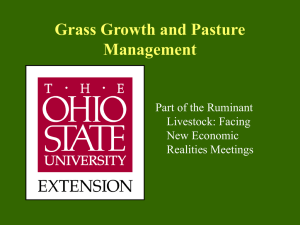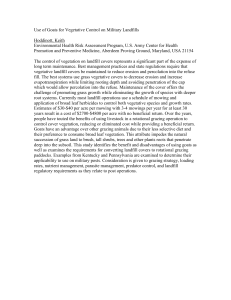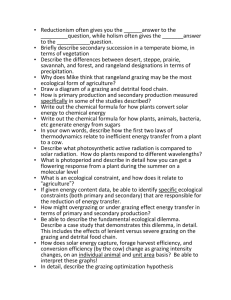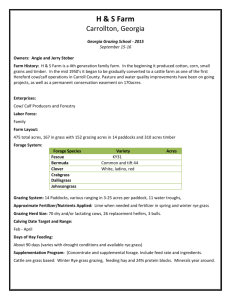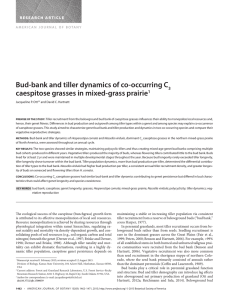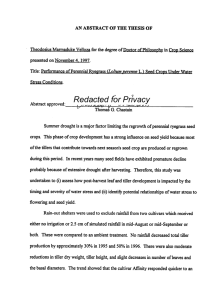Study Questions Week 1 for Thursday
advertisement
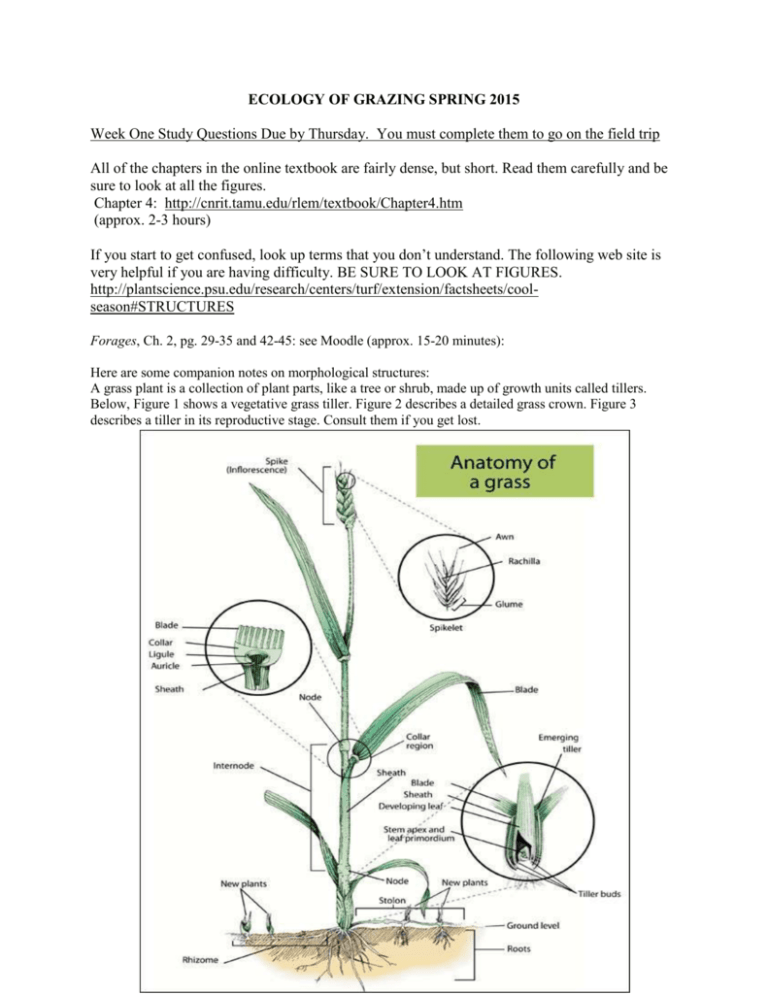
ECOLOGY OF GRAZING SPRING 2015 Week One Study Questions Due by Thursday. You must complete them to go on the field trip All of the chapters in the online textbook are fairly dense, but short. Read them carefully and be sure to look at all the figures. Chapter 4: http://cnrit.tamu.edu/rlem/textbook/Chapter4.htm (approx. 2-3 hours) If you start to get confused, look up terms that you don’t understand. The following web site is very helpful if you are having difficulty. BE SURE TO LOOK AT FIGURES. http://plantscience.psu.edu/research/centers/turf/extension/factsheets/coolseason#STRUCTURES Forages, Ch. 2, pg. 29-35 and 42-45: see Moodle (approx. 15-20 minutes): Here are some companion notes on morphological structures: A grass plant is a collection of plant parts, like a tree or shrub, made up of growth units called tillers. Below, Figure 1 shows a vegetative grass tiller. Figure 2 describes a detailed grass crown. Figure 3 describes a tiller in its reproductive stage. Consult them if you get lost. Figure 1: A simplified vegetative grass tiller. Leaf 1 is oldest and leaf 8 is just being exerted. The enlarged area of the crown shows the apical meristem that produced the leaves. New leaves push up from the center of the rolled tube portion of the first leaf; the growth is similar to the extension of a telescope. The growing point (apical meristem) is at or near the soil surface where leaves form, protected from grazing. _______________________________ Figure 2: Cross section of the crown and tillers. 'Node n' is the oldest and 'Node n+4' is just forming. (A) Blade intercalary meristem, where blade cells divide and elongate. (B) Sheath intercalary meristem, where sheath cells divide and elongate. The shoot apex lays down cells that can form into a variety of structures. At what stage in the life-cycle do you think the grass plant at left is? Intercalary Meristem Figure 3: A reproductive grass tiller. This tiller has a stem (or culm) and seedhead that differs from the tiller in Figure 1. Intercalary meristematic tissue at the base of the leaf blade, above the ligule, is the area where cells divide so the leaf can extend. _______________________________ Vegetative tillers consist primarily of leaves (Figure 1). Grazing removes leaf tissue but, in dutifully managed systems, will not harm the growing point that produces the leaves. If not defoliated, the apical meristem will elevate, beginning growth of the reproductive inflorescence (Figure 3). Management determines whether a tiller will stay vegetative (Figure 1), or become reproductive and produce seedheads (Figure 3). Whether a tiller becomes reproductive also depends on environment and hormones produced in the plant. For producers, understanding the growing behavior and architecture of a vegetative tiller is very important (see the Benefits of Vegetative Growth section in Heitschmidt, Ch. 4). The basal area of the stem, from which everything arises, is the crown (Figure 2). The crown has a number of buds (growing points) that produce tillers and roots. New tillers are anatomically and physiologically connected to older tillers. Therefore, several connected tillers may all live and share water, carbohydrates, and nutrients. An apical meristem (Figure 2) is responsible for leaf formation; the intercalary meristem at the base of leaf blades and sheaths are responsible for leaf expansion (Figure 2 A, B). Each leaf is rolled into a tube-like form in its lower portion and unfurls as the blade extends. Subsequent leaves follow the same pattern. Above, this diagram shows conceptually the most actively dividing meristematic tissue in a maturing grass phytomer (Etter, 1951). Notice at stage 2, nearly the entire phytomer is comprised of meristematic cells. By stage 9, the meristematic tissue is more localized to the base of the phytomer, though it has continued to elongate. Try to identify the locations of intercalary meristematic tissue (hint, look at Fig. 2 A and B). Left, the basic repeating unit of growth of a tiller is the phytomer. It consists of a node, an internode, a leaf sheath, a leaf blade, and an axillary bud. These structures arise from the area called the crown. Study Questions – Heitschmidt, Ch. 4, Grass Development and Morphology 1. Briefly describe the difference between developmental morphology and physiological process in general terms. 2. Why do we need to learn about the developmental morphology and physiological function of the dominant plant species in order to conserve rangeland resources and maintain production stability? 3. Specifically, how does grazing result in reduced plant growth? How have plants adapted to compensate for this? 4. Draw and label a basic phytomer. What does the phytomer originate from? 5. Apical/terminal meristems and intercalary meristems are very important. Draw your own diagram of an apical meristem, and show where intercalary meristems may exist. Imagine how leaves can grow from them. Important quote: "The basal location of the intercalary meristem within the blade and sheath explain why leaf elongation can occur following defoliation without replacement of the leaf tip." 6. How does Heitschmidt define a tiller? 7. True or False: Vegetative tillers and reproductive tillers are morphologically identical until floral induction. 8. True or False: Intravaginal tiller development is to bunchgrass as extravaginal tiller development is to sodgrass. 9. What factors can promote tiller development? 10. Which root system sets up initially? 11. Which root system is permanent in perennial grasses? 12. Tiller density increases when ___________ exceeds ___________. 13. What time of year does tiller recruitment usually occur in temperate perennial grasses? 14. True or False: Tillers recruited early in the growing season often overwinter in a vegetative stage and resume growth the subsequent spring. 15. True or False: Defoliated tillers derive support from associated, non-defoliated tillers. 16. What is the difference between grazing tolerance and grazing avoidance mechanisms in terms of grazing resistance in plants? 17. In dicots, where typically are meristems located? Compare to monocots (grasses) in terms of grazing pressure. 18. Give three concrete examples of mechanical mechanisms that plants use to avoid grazing. 19. Give one example of a biochemical mechanism that plants use to avoid grazing. 20. What does Heitschmidt mean by some compounds being "costly to produce"? 21. What is an "inducible defense" mechanism? 22. Define leaf replacement potential. 23. Compare the 'activity' of intercalary meristems with axillary buds in terms of their leaf replacement potential. 24. Define compensatory photosynthesis. How significant a mechanism is this in terms of grazing tolerance? 25. True or False: Plant growth is more dependent upon current photosynthesis than stored carbon within 3 days of defoliation. 26. How does removal of shoot volume effect root growth (be specific). 27. What is the significance of the following statement: “Grazing at the time of culm elongation or thereafter reduced subsequent tiller recruitment while grazing prior to culm elongation produced little affect in comparison with ungrazed plants.” Why would this be true? 28. Draw a picture showing the differences between an individual, population, and a community in grasslands, in terms of hierarchy and tillers. 29. In detail, what does Fig. 4.11 demonstrate? 30. In detail, explain how sheep grazing sagebrush steppe can shift community composition toward grass dominance more rapidly than the total exclusion of grazing. 31. Draw a flow diagram using your own words, showing how grazing can alter plant species composition at a community level. Study Questions – Forages, Ch. 2, pg. 29-35 and 42-45 This reading is much less technical than Heitschmidt, so use it to check your understanding. Begin reading from Plant Structures and Development. 1. Describe the difference between a vegetative tiller and a reproductive tiller in terms of the shoot apex. 2. Fig. 2.5 C, notice the folded blade-shape of orchard grass. It's very easy to identify in the field and we will see it often. 3. Describe the various functions and qualities of the crown and identify structures (in perennial grasses) that can be produced from it. 4. What is a rhizome and from where does it originate? What benefits do rhizomes offer perennial grasses? 5. What is a stolon, from where does it originate, and what makes it different from a rhizome? 6. You can stop reading at Inflorescence (bottom pg. 35) and start again from the 1st paragraph of page 42. 7. Again, list the basic units of the phytomer. 8. What occurs to the phytomer once it goes reproductive? 9. Where does the "flag leaf" emerge and what does it signify is happening to the grass plant? 10. Page 43 describes the chronology of events in phytomer development. Imagine the sequence of events for a growing blade: beginning from a node (bud) at the primordia, the various locations of intercalary meristematic tissue, and how the blade pushes up through previous sheaths. Does the blade itself always grow? Or are there other structures that push the blade out as it matures? What are those structures? 11. What would you look for to distinguish between an intra- and extravaginal tiller? 12. The 6 developmental stages of grass morphology may be helpful in understanding and referring to the life cycle of vegetative and reproductive tillers. List and briefly describe them.
